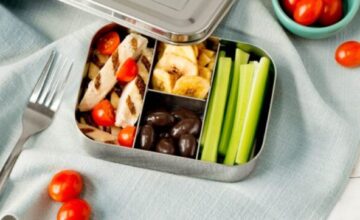
1. Uncut melons
Chilling whole melons—whether watermelon, cantaloupe or honeydew—takes up way too much room in the fridge. More importantly, keeping these mega fruits in the icebox halts the ripening process, meaning they won’t be as tasty as if they’d been kept at room temperature. Chilly temps also reduce the healthy antioxidants found in melons. Keep these fruits on the countertop until they’re ready to eat. If you have leftovers, store them in an airtight container in the fridge for up to three days.
2. Raw potatoes
Don’t dump that bag of spuds in the crisper drawer! Frigid temperatures alter the starchy complex carbohydrates found in raw potatoes, giving them a sweet taste and a gritty mouthfeel when cooked. For the best flavor and texture, store raw potatoes in a well-ventilated basket or drawer, out of direct sunlight.
3. Honey
Due to its high sugar content, honey, a natural preservative, needs no refrigeration. In fact, popping that honey bear in the fridge virtually guarantees you won’t be able to squeeze out the golden goodness. When refrigerated, honey hardens and crystalizes, so store it on a shelf in your pantry. If you already made the mistake of refrigerating it, don’t toss it out. Place the honey bottle in a pan of hot (not boiling) water until it returns to its liquid state.
4. Coffee
If you want to savor your cup of aromatic coffee in the morning, don’t store the beans in the fridge. An open package of coffee is subject to condensation in the cold temps of the fridge, which zaps flavor. Additionally, fresh grounds will absorb the odors of other refrigerated foods, making your coffee taste off. For the best tasting cup of Joe, store your coffee in an airtight container at room temperature in a dark place, such as inside a cabinet.
5. Tomatoes
6. Onions
The chilly temps and high humidity of the fridge wreak havoc on onions, breaking down their fibrous structure, and leaving them mushy and prone to mold growth. For the best flavor and texture, store onions in a well-ventilated, dark and cool (not cold) spot. An open-weave basket in the pantry is optimal.
7. Bread
Store your bread in a bread box or on a cabinet shelf, but not in the fridge. Refrigerating bread slows mold growth but makes the bread tough, chewy and stale-tasting. If you know you won’t use the whole loaf before it goes bad, wrap the excess in freezer paper and store it in the freezer for up to one month.
8. Green avocados
Many avocados available at the grocery are green and hard, and need a couple days to ripen before they’re ready to eat. They’ll only ripen, though, if you keep them out of the fridge. The only time you should refrigerate an avocado is when it’s completely ripe but you’re not ready to use it. Then, refrigeration will give you an additional day or two before it goes bad.
9. Strawberries
Refrigerating strawberries reduces their sweet flavor and gives them a mushy texture. For better taste, store fresh strawberries on the countertop, out of direct sunlight, and use them within a day or two of picking or purchasing. And don’t wash them until you’re ready to eat them; strawberries go bad more quickly after they’re washed.
10. Fresh garlic bulbs
Nothing adds flavor to dishes quite like fresh garlic, but if you store the bulbs in the fridge, don’t be surprised if they sprout bitter green shoots. Another danger, garlic bulbs are prone to mold growth in the humid conditions of the fridge. For the best taste, store fresh garlic in a dark, well-ventilated spot. You can store leftover minced garlic in the fridge for a day or two, but the flavor can’t compare to freshly minced cloves.




